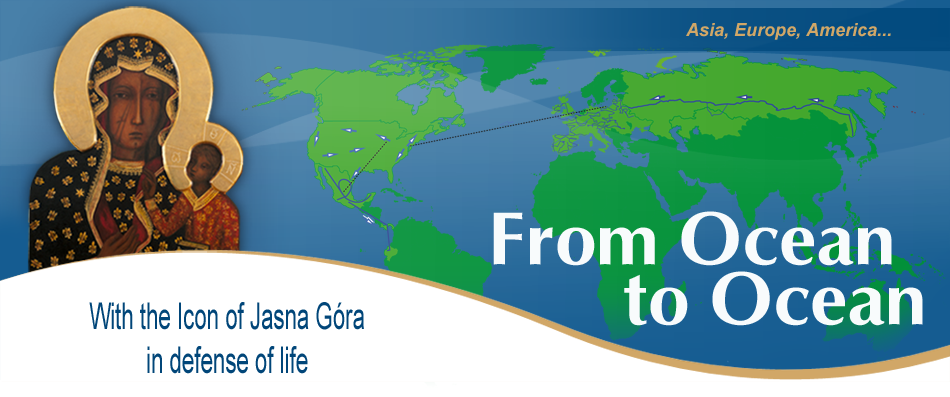Early afternoon, on Friday, August 24, the Icon of Czestochowa, peregrinating across the world in defense of life, had arrived in Krakow (also known as Cracow) at the Pauline Fathers shrine at Skalka on the bank of the largest Polish river - named Wisla.
The Basilica of St. Stanislaus Bishop and Martyr at Skalka, along with the crypt underneath it, is the National Shrine of Poland, and has strong ties to the nation's history.
It was in this very church in the year 1079 AD when the Polish King, Boleslaw Smialy, arrogantly breaking God's Commandments, furious due to the reminders and warnings of the courageous Bishop of Krakow, Stanislaus, killed him with his own hands, while the bishop was celebrating Mass at the church altar. This traumatic event had strong consequences for the Polish nation. The king lost his power, had to leave the country, and spent the remainder of his life doing penance for his sins. On the other hand, Stanislaus – the Bishop of Krakow-, who heroically defended the moral law and the Church, was pronounced a Saint and is the Patron Saint of Poland. John Paul II – as the successor of St. Stanislaus and Bishop of Krakow – referred to Skalka with great devotion surrounding it with his prayers and oftentimes referred to this confrontation between the public and religious authorities while the continuing conflict with the Communist authorities in Poland lasted. Every year, for the past several hundreds of years, on the patronal Feast Day of St. Stanislaus (May 8), there takes place a great, very solemn procession with the reliquary containing the blood of St. Stanislaus. The procession goes from Skalka to the Royal Cathedral at Wawel (in Cracow), where the Bishop's sarcophagus is located. In the crypt, underneath the church at Skalka, are the graves of the well-deserved sons and daughters of Poland: numerous writers, artists, and the creators and contributors to the Polish Culture.
After the welcoming ceremony at Skalka, the Icon of Czestochowa was brought inside the basilica and placed on the left side of the main altar, next to the historical place, where traces of blood of the martyred bishop remain to this day. The church was filled mainly with the numerous pro-life leaders from Krakow and the southern region of Poland, representing multiple organizations and pastoral groups. It was here, in Krakow, that the first movement of prayer for the defense of life had been founded – it is called the Crusade of Prayer for the Unborn (in danger of abortion). This movement was initiated by the laity led by Engineer Anthony Zieba, who also organized the current visitation of the Icon of Czestochowa in Krakow.
Monsignor Stanislaus Maslanka presided over the solemn celebration of the Holy Eucharist. He is the current pastoral assistant of the" Crusade of Prayer for the Unborn" movement. During his homily, the Monsignor reminded the faithful, that man has received a free will from God, the Creator. Man can say "yes" to God, but can also say "no." That happened already in Paradise, when Adam was defeated and gave in to Satan's temptation: "you shall be as gods." Since the time of the Original Sin, human weakness remained in man. Man suffers and gives in to evil much easier due to that weakness caused by original sin. The modern man attempts to take on the role of God and wants to be the creator and lord of life. This desire to "play God" leads to great drama and, because of today's modern technology and access to information, is a threat to all of humanity. Yet, Mary comes to us to accompany us, to lead us to Her Son, and to heal us. The several hour-long prayers at the Shrine at Skalka ended with the Jasna Gora Bugle Call (Apel). The Augustine religious sisters took over keeping the watch during the night.
The arrival of Our Blessed Mother in Krakow did not occur without a slight problem. Due to the malfunction of the trailer suspension (of the trailer that houses the glass shrine for the Icon), the left rear tire had burned. This happened less than 5km (ca. 3 mi), before the Icon had reached the shrine. Our Lady in Her Icon had to be transferred to a passenger car, in order to make it to the church with only a small time delay. The glass shrine on wheels had to be taken apart, the tire had to be replaced, and the trailer suspension had to be welded. Providence provided skilled tradesmen, who quickly came to assist. At midnight, when everything was ready, a great wind arrived, forecasting a powerful storm.








